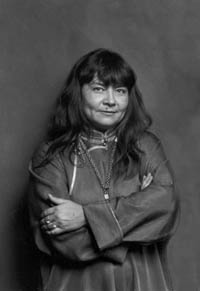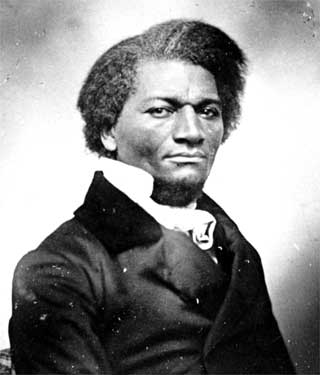|
Tuesday 8/24
Introduction to and overview of the course; meet each other,
form
discussion/report groups: look over the units and their student mini-lectures;
choose a unit to be associated with and a report to give.
UNIT 1: NATIVE VOICES: Resistance and Renewal
in Native American Literature
Video 1: NATIVE VOICES: Resistance and Renewal in American Indian Literature
What to Think About
While Watching:
What are some of the characteristics of Navajo and Pueblo oral traditions?
In what sense do these writers draw on native oral traditions and beliefs?
How do they speak to the experience of being American Indian?
What does their written literature hope to do or achieve?
Thursday 8/26
Go to the "American Passages" unit 1 link (see above);
read the Silko, Ortiz, Tapahonso and Erdrich author backgrounds:
http://www.learner.org/amerpass/unit01/index.html
Print out and read:
Leslie Marmon Silko, "Yellow Woman" (pdf)
Simon Ortiz, "8:50 AM Ft. Lyons VAH,"
"My Mother and My Sisters," (poems/pdf)
Luci Tapahonso, "A Breeze Swept Through,"
"They Are Silent and Quick" (poems/pdf)
Bring these printouts to class with you, ready to discuss them closely.
For discussion:
What
are some specific Navajo or Pueblo oral traditions or beliefs that you can see
reflected in the written literature of these writers? What do these writers seem
to be doing, or trying to say, by employing these traditions? How does Native
American history, and the history of the contact between natives and Europeans,
affect their contemporary writing? How are their texts a combination of Native
American and European literary traditions?
Tuesday 8/31
Norton,
Introduction: Literature to 1700/ Timeline, pp. 3-20
How does this section present America as a highly multicultural world?
Who is Diego Colon?
How were Natives displaced or killed in the Caribbean and Central/South
America?
Why does the Norton mean by "institutional disease of slavery" (5)?
What were the 3 main purposes of European explorers' writings at this time?
Native American Creation Stories
Stories of the Beginning of the World, pp 19-33
* hundreds of languages, multiple types of Orature
* 8 types of creation stories: many are "Earthdiver" or "Emergence" Stories
What is the Iroquois League of Nations?
What are Rituals of Condolence and why/how did they come about?
Who are the main characters in the Iroquois creation story?
Why do you think the twin motif is common?
Pima Creation Story
What do find notable in this story?
Nez Perce Creation Story: "Coyote and the Swallowing Monster"
"Coyote's Elbox Child" and
"Coyote and the Shadow People"
How Indians were created, including the Nez Perce, how Coyote had a baby, and
how death became permanent
Thursday 9/02
Native American Trickster Tales,
72-74
Sioux: "Ikto Conquers Iya, the Eater" p. 83-86
Koasati: "The Bungling Host" p. 86-91
Clatsop: "Coyote- His Myth" p. 91-97
Student mini-lectures:
"God Is Red": The Clashes and Contacts of Native Religion and Christianity:
Andrea Carr
"Healing Arts: The Navajo Chant (Nightway)": Stacey Penoncello
The Nightway Chant
House made of dawn.
House made of evening light.
House made of the dark cloud.
House made of male rain.
House made of dark mist.
House made of female rain.
House made of pollen.
House made of grasshoppers.
Dark cloud is at the door.
The trail out of it is dark cloud.
The zigzag lightning stands high upon it.
An offering I make.
Restore my feet for me.
Restore my legs for me.
Restore my body for me.
Restore my mind for me.
Restore my voice for me.
This very day take out your spell for me.
Happily I recover.
Happily my interior becomes cool.
Happily I go forth.
My interior feeling cool, may I walk.
No longer sore, may I walk.
Impervious to pain, may I walk.
With lively feelings may I walk.
As it used to be long ago, may I walk.
Happily may I walk.
Happily, with abundant dark clouds, may I walk.
Happily, with abundant showers, may I walk.
Happily, with abundant plants, may I walk.
Happily on a trail of pollen, may I walk.
Happily may I walk.
Being as it used to be long ago, may I walk.
May it be beautiful before me.
May it be beautiful behind me.
May it be beautiful below me.
May it be beautiful above me.
May it be beautiful all around me.
In beauty it is finished.
In beauty it is finished.
'Sa'ah naaghéi, Bik'eh hózhó
Tuesday 9/07
No Class: You are welcome to attend the lecture in the Clearwater Room at 12:30 get Thursday and Tuesday's reading
done
Thursday 9/09
Read the author backgrounds on the American Passages website
Black Elk Speaks (pdf)
1. Who is Black Elk? Why does he receive the vision?
2. What seems to be the purpose of the Grandfathers' council that Black Elk
attends? What do the Grandfathers want to teach Black Elk?
3. Consider the recurrence of the hoop in Black Elk's vision. For the
Sioux, circles stand for the cyclical, interconnected nature of life itself.
Given this, how does the appearance of the hoop affect the significance of
Black Elk Speaks?
4. Black Elk's revelation occurred in 1872 when he was 9 years old--17
years before the Ghost Dance religion came to the Sioux nation. How does Black
Elk's vision compare to the motifs present in the Ghost Dance songs?
5. What is the "good red road" described in Black Elk's narrative.
6. What was Black Elk bringing to his people and how/why was "the hoop
broken"?
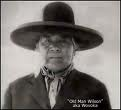 Wovoka (Piaute) Wovoka (Piaute)
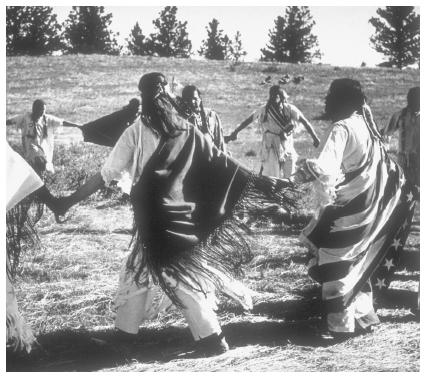 Ghost Dancers Ghost Dancers
Ghost Dance Songs (pdf)
1. What are the major motifs of these songs?
2. What is the purpose of the Ghost Dance?
3. What is "approaching" or "coming" according to these songs?
4. Why would contemporary Native people refer to their writing (like
Sherman Alexie), or art as a form of the Ghost Dance or like Ghost Dancing?
Scott
Momaday on Wounded Knee with photo gallery
December 29, 1890
Wounded Knee Creek
In the shine of the photographs
are the slain, frozen and black
on a simple field of snow.
They image ceremony:
women and children dancing,
old men prancing, making fun.
In autumn there were songs, long
since muted in the blizzard.
In summer the wild buckwheat
shone like fox fur and quillwork
and dusk guttered on the creek.
Now in serene attitudes
of dance, the dead in glossy
death are drawn in ancient light.
N. Scott Momaday
Massacre at Wounded Knee Creek 1890
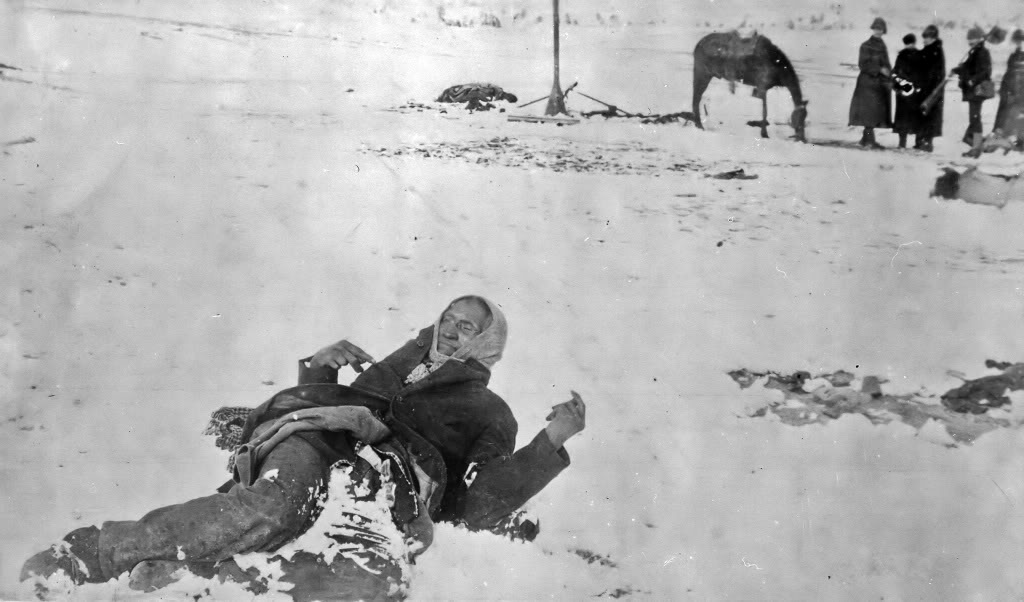 
Chief Big Foot, who was leading the group to the Agency for food
Burial of Sioux kiled at Wounded Knee, December 29, 1890
Oral Litertaure/Witnessing to History 1970s rock band Redbone:
Redbone:"We
Were All Wounded at Wounded Knee"
Redbone:
"Wovoka"
Louise Erdrich, "Fleur" (pdf)
The story is set in 1913 on a fictional Chippewa (Ojibway/Anishinabe)
reservation in North Dakota and is narrated by Pauline Puyat, a mixed-blood
Chippewa girl who later becomes an antagonist to Fleur as well as a Catholic nun.
Pauline is fearful and confused. "Fleur" explores both Fleur's power and
Pauline's self-deception.
Manitous are Chippewa gods/spirits that provide people with
food (through hunting) and good health. The underwater manito could both save
people or drown them. Windigos are cannibals made of ice, or people whose insides
are ice. "Going windigo" is associated with starvation as well as greed.
1. Why is Fleur so threatening to men? How do they respond to
this threat?
2. By the end of the story, who does it seem did the actual locking up of
the men in the meat locker?
3.
How are we meant to evaluate Fleur? How do the initial supernatural hints
inform our feelings about her? What is her relationship to her Chippewa
heritage?
4. How are we meant to evaluate the narrator, Pauline? What are we to make
of her rejection of the Chippewa, her assertion she "was made for better"? Why
does she not help Fleur?
5. Consider what it means that Fleur maintains this close relationship to
the spirit realm even in the face of white settlement. What role does the
supernatural play in the story?
Joy Harjo,
"Postcolonial Tale"
Student mini-lectures:
"Native Weavers and the Art of Basketry": James Arrick
"Sacred Play: Gambling in Native Cultures": Dylan B.
Tuesday 9/14
conclude Unit 1: listen to "We Were All Wounded at Wounded Knee," discuss "Fleur",
"Postcolonial Tale" and "Sacred Play" presentation
Thursday 9/16
UNIT 2: EXPLORING BORDERLANDS: Contact and
Conflict in North America
Watch:
VIDEO 2: Exploring Borderlands
How has the southwestern border region
changed over time?
What political and social issues have shaped the literature
of the borderlands?
What is the relationship between the conquerors and
conquered?
How do these writers articulate an ideal of a mixed and inclusive
identity?
How does the Chicano notion of "historia" complicate
traditional Anglo ideas about the distinction between history and fiction? What
traditional stereotypes have been applied to mestiza women?
How have women
restructured and redefined the identities open to them in the borderlands?
See Glossary Unit 2
Read the Unit 2 Overview and author backgrounds at:
http://www.learner.org/amerpass/unit02/index.html
C. Columbus, pp 31-35
- In his "Letter to Luis de Santangel," Columbus declares that he has
"taken possession" of the islands for "their highnesses" Ferdinand and
Isabella of Spain. What procedures does Columbus follow in order to take
possession? What kind of attitude toward the native inhabitants' rights
underlies the ritual of possession that Columbus employed?
- Columbus is clearly aware that the lands he "discovered" already have
native Indian names. In his "Letter to Luis de Santangel," for example, he
explains that the Arawak Indians call their island "Guanahani." Yet Columbus
seems to have no reluctance about renaming the islands he visits, sometimes
for religious reasons (San Salvador) and sometimes after Spanish royalty
(Fernandina). Why does he feel justified in renaming the islands? What might
he have hoped to accomplish in bestowing these Spanish names? How might his
act of discovering and naming relate to the biblical account of Adam naming
objects in Eden in the Book of Genesis?
- Columbus Day (the second Monday in October) has been celebrated as a
national holiday since the early twentieth century. What are Americans
supposed to be celebrating on that day? Should Americans continue to observe
Columbus Day? Does the fact that the holiday was first instituted by Italian
immigrant groups seeking to solidify their position in American society
affect your assessment of its significance? Do you know about "Indigenous
Peoples Day"?
John Smith, pp 55-72
Smith's first account does not mention Pocahontas helping him to escape
captivity and avoid execution. Only 16 years after his encounter with Powhatan,
and after Pocahontas had converted to Christianity and married John Rolfe,
traveled to England and been presented at Court, does Smith write about their
contact. What reasons would Smith have for revising his account in this
way? What assumptions about Indian-European relations, gender, and politics
underwrite this story? Why has this story achieved archetypal status?
Provide other examples of this trope of an attractive young
woman intervening on behalf of her colonizer. Why is it repeated and celebrated?
What kind of fantasy about American power does it represent?
Bartolome
de las Casas, 35-39
las Casas's account is quite graphic: the Spanish conquerors gleefully drown
children, dismember pregnant women, and torture captives over smoldering fires.
Why might he have chosen to represent so vividly the horror of the Spanish
Conquest from the Indian point of view? How does his description reverse common
European stereotypes about the "savagery" of American Indians? What kind of
audience does he assume will read his work? Why does he consistently refer to
the torture and murder of women and children? How effective is his strategy?
Aristotle and later Christian philosophers believed in "The Great Chain of
Being," a hierarchy that put God at the top and "non-being" things like
rocks at the bottom. Several hierarchies existed in the category of "Man"
separating the "primitive" from the "civilized." How might the Spanish
conquerors be influenced by The Great Chain of Being? Is it still influential
today, and if so, in what ways?
Bernal Diaz
del Castillo, 42-58
del Castillo was a soldier, not a nobleman or officer, and his narrative
emphasizes the role of the ordinary footsoldier in contrast to the narratives of
the powerful like Cortes. Diaz did not gain wealth or fame but the Crown gave
him a modest encomienda, a grant that allowed him to command Indians to
labor for and pay tribute to him--in effect, a system of slavery.
Like las Casas, del Castillo describes the destruction and
violence the Spanish visited on native cultures in the Americas; how does Diaz
del Castillo's attitude differ from las Casas'?
Consider del Castillo's description of the sacrifice and and cannibalization of
his countrymen by Aztecs on the altar of their Huichilosbos.. As contemporary
readers, how might our knowledge of the destructiveness and brutality of
European actions in the New World affect our understanding of this scene?
Cabaza de Vaca, 40-48
- How does Cabeza de Vaca survive among the various Native American groups
he encounters? What skills does he draw on and develop? What strategies does
he use to fit into native communities
- Why does Cabeza de Vaca come into conflict with Spaniards he encounters
in Mexico? Why does he refer to his encounters with them as "confrontations"
and "falling-outs"?
- When Cabeza de Vaca traveled through what is now the southwestern United
States and northern Mexico, there was of course no official border between
the two areas. Nonetheless, do you think he might have had a sense of
himself as inhabiting a kind of "borderlands"? In what ways?
4. When Spanish colonists arrived in the Americas, they sometimes encountered
berdaches--Native American males who cross-dressed and performed female
sex and social roles. While this form of transvestism was often widely accepted
in native cultures, it frightened the Spanish. In his narrative, Cabeza de Vaca
writes of the "soft" native men of Florida who dressed and worked as women. Why
might the berdache have been so threatening to the Spanish? What notions of
masculinity and femininity are implicit or explicit in the narratives about the
conquest? How do the berdaches threaten (or reinforce) this gendered
system?
At the conclusion of the excerpt from the Relation in The Norton
Anthology of American Literature, Cabeza de Vaca explains that the
Indians refused to believe that he and his group were of the same race as
the "Christian slavers" they encountered in Mexico. Their "naked and
barefoot" appearance as well as their gentleness and generosity seemed to
separate them, in the Indians' minds, from other Spaniards. Look at this
segment of the narrative carefully, examining it for indications of Cabeza
de Vaca's own racial and national identification. Does he see himself as "of
the same people" as the Christian slavers? How has his identity as a
European and as a conquistador altered over the course of his time among the
Indians? - In the section entitled "Our Life among the Avavares and Arbadaos,"
Cabeza de Vaca explains that exposure to the southwestern sun caused the
members of the European group to "shed our skins twice a year like snakes."
After pointing out the physical and mental transformation implied in this
image of skin-shedding, find other moments where Cabeza de Vaca symbolically
indicates that he is undergoing a kind of metamorphosis. His accounts of
acquiring a taste for native foods and his use of birth imagery might be
good places to start.
Student mini-lectures:
"Shared Spaces: Contact Zones and Borderlands":
Derek Arnold
"Model Women: La Virgen de Guadalupe, La Lloronoa, and La Malinche as
Archetypes of Mexican Femininity": Lisa Heer
Assign
EXAM/Essay 1
Tuesday 9/21
Discuss readings from Thursday above
Parades, Americo from George Washington Gomez (pdf),
Corrido: Gregorio Cortez (pdf)
Describe Gualinto's identity and identity crisis. Living in Texas, going
to an Anglo-run school, what are some of his experiences? Are we left hopeful he
can live up to the name his father gave him?
Anzaldua, Gloria from Borderlands/La Frontera (pdf)
What is a Chicana? A Mestiza? what does Anzaldua mean when she calls for
"a new mestiza consciousness"?
How does the new mestiza compare to the ideals of femininity expressed in
the 3 traditional representations of women in Mexican culture, La Virgen de
Guadalupe, La Malinche, and La Llorona?
What does Anzaldua argue is the relationship between the "queer" and "the
borderlands"?
How is language a borderland for her and others?
Why does she think the mestiza consciousness is necessary in today's
world?
What is your response to her poem, "El sonavabitche"? How is it an example of
historia?
Student Mini-Lectures
"The Romance of Colonization": Kyra Fullmer
"Writing Without Words: A Native American View of Culture and Conquest": Cat
Van Dusen
"Working Wonders: The Experience of "La Maravilla/The
Marvelous" in New World Encounters": Eric Sanden
Thursday 9/23
conclude Unit 2 with discussion of literature
UNIT 3: UTOPIAN PROMISE: Puritan and Quaker
Utopian Visions, 1620-1750
Read Unit Overview
Tuesday 9/28
Watch the video on your computer:
http://www.learner.org/amerpass/unit03/index.html
VIDEO 3: UTOPIAN PROMISE
What to think about while watching:
1.
How did the Puritans and Quakers respond to the social and political
pressures caused by their immigration to a "New World"?
2. How did they react when they came into contact with other immigrant
groups and with Native Americans?
3. How do the writers and texts explored in the video formulate enduring
myths about America?
4. How have their values and beliefs shaped American culture and
literature?
William Bradford, pp. 104-top of 126 (to First Thanksgiving)
1. In Chapter IV, Bradford refers to
America as a "vast and unpeopled" country, but his subsequent account of the
Plymouth settlement attest to the fact that the land was far from uninhabited.
What other kinds of people do the Plymouth settlers encounter of their voyage
and in the New world? How does the presence of "strangers" work both to
challenge and to solidify the Puritan community?
2. Compare Bradford's account of the Puritans' "First Thanksgiving" with
contemporary ideas about the landing at Plymouth Rock and the holiday. Why have
these invented traditions and myths become so central to ideas about America's
national beginnings?" Why are the Puritans considered such an important starting
point for America's national culture?
3. How does having read Units 1 and 2 affect your reading of Unit 3 and
America's "Puritan beginnings"?
John Winthrop, pp. 147-164 (through Mrs. Hutcheson delivers a child)
1. Locate several typologizing moments in Winthrop's "A Model of
Christian Charity"; What is the significance of the Puritans' insistence on
understanding their own history as prefigured by the Bible? What kinds of
pressures might this tendency to read biblical and divine significance into
everyday affairs put on individuals and on communities? How might it work to
comfort and reassure people?
2. What kinds of internal and external threats undermined the unity of the Mass.
Bay Colony?
3. What happened to people who deviated from orthodox religions tenets? What
rhetorical strategies does Winthrop adopt when characterizing people whose
beliefs were different from his own?
4. What does the role of gender play in Winthrop's attack on Anne Hutcheson?
5. In Sep. 1638 Winthrop notes in his Journal that Hutcheson gave
birth to a stillborn, misshapen child. In the 16th and 17th C., stillborn and
deformed births were considered "monstrous births" and understood to be a
representation of God's displeasure or the devil's influence over the mother.
How does Winthrop describe Hutcheson's "monstrous birth"? Why does her
miscarriage seem so significant to him? What is his attitude toward motherhood,
women's bodies, and childbirth (Hutcheson was a midwife for many years prior to
her banishment).
6.Why has Winthrop's metaphor of a "City on a Hill" had so much on American
culture? Do you see evidence of the endurance of this idea within contemporary
public discourse?
W. Penn,
Letter to Lenape Chiefs (pdf)
We will be brethren, my people and your people, as the children of one
father. All the paths shall be open to the Christian and the Indian. The doors
of the Christian shall be open to the Indian and the wigwam of the Indian shall
be open to the Christian.
The Christian shall believe no false stories, the Indian shall believe no
false stories, they shall first come together as brethren and inquire of each
other; when they hear such false stories they shall bury them in the bottomless
pit.
The Christian hearing news that may hurt the Indian, or the Indian hearing
news that may hurt the Christian, shall make it known the one to the other, as
speedily as possible, as true friends and brethren.
The Indian shall not harm the Christian, nor his friend; the Christian shall
not harm the Indian, nor his friend; but they shall live together as brethren.
As there are wicked people in all Nations; if the Indian or the Christian shall
harm the one or the other, complaint shall be made by the sufferer, that right
may be done; and when right is done, the wrong shall be forgotten, and buried in
the bottomless pit.
The Indian shall help the Christian, and the Christian shall help the Indian,
against all evil men, who would molest them.
We will transmit this League between us to our children. It shall be made
stronger and stronger, and be kept bright and clean without rust or spot,
between our children and our children’s children, while the creeks and rivers
run, and while the sun, moon, and stars endure.
1. How do Quaker and Puritan theology differ? How
have the values of each group had a lasting effect on American values, politics
and national character?
2. How might different views of spirituality have affected the way Puritans and
Quakers chose to deal with Native Americans?
3.Why do you think Penn acknowledged the history of European exploitation of
Indians in his letter? What effect do you think it would have had on the Native
Americans to whom the letter is addressed?
4. What role did the Quaker tradition in Pennsylvania have in the development of
America as a nation?" Do you see any legacies of Quaker thought and practice
within our culture today?
Student mini-lectures:
"Plain Style: Keeping it Simple": Craig Lovelace
"Souls in Need of Salvation, Satan's Agents, or
Brothers in Peace?: English Settlers' Views of Native Americans": Clayton Fosberg
Thursday 9/30
Exam/Essay 1 DUE
Student mini-lectures:
"The Doctrine of Weaned Affections: In Search of Spiritual Milk":
Hawley Conger
"Puritan Typology: Living the Bible":
Kevin Alt
Catch up on discussing readings
A. Bradstreet, 187-188, 204: "The Author to Her Book," "Before the Birth of
One of her Children", "To My Dear and Loving Husband,"
Mary Rowlandson, 235, 236-267
The Captivity Narrative and
The
Jeremiad
1. Rowlandson opens her narrative with totalizing, dehumanizing descriptions of
Native Americans as "hell-hounds," ravenous beasts," and "barbarous creatures."
As the text progresses, however, she seems to become more wiling to see her
captors as individuals, and even as people capable of humanity an charity.
Analyze her portraits of individual Indians and trace the evolution of her
attitude toward Indians in general. Which Native Americans come in for the most
criticism? Which does she view more positively? What might motivate her varying
assessments? How might changes in Rowlandson's own status within the Wampanoag
encampment influence her attitude toward individual Indians?
2. How does Rowlandson use typology in her narrative? What kinds of biblical
images does she rely on to make sense of her captivity?
3. Many scholars view the captivity narrative as the first American genre and
trace its influence in the development of other forms of American
autobiographical and fictional writings. Why do you think the captivity
narrative became so popular and influential? What might make it seem
particularly "American"? Can you think of any 19th or 20th century novels or
films that draw on the conventions of the captivity narrative?
Samson Occom (Mohegan) 440-443
1. When does Occom feel he is being treated unfairly? What is his concept of
justice? How does he deal with the prejudice ad mistreatment he experiences?
What rhetorical strategies does he use to present his complaints in his
narrative?
2. Compare Occom's description of Indian life and Indian identity with the
perspectives on Indians offered by other writers in this unit (Bradford, Morton,
Rowlandson, or Knight, for example). How does Occom's narrative of Native
American life complicate or challenge the perspectives of the English writers?
Does his account have anything in common with their accounts?
3. In his life, Occom managed to inhabit what often seemed to be two very
separate cultures: he wrote and preached in English and committed himself to the
Christian theology taught by white people, yet never lost his commitment to his
identity as an Indian. How does Occom's narrative provide evidence of the
strategies he adopted in order to live in 2 separate cultures at the same time?
What tension does this hybrid or dual identity produce in the narrative? (This
problem of hybridity or duality is a major theme in many works by American
writers. You might compare Occom's piece to William Apess's "An Indian's
Looking-Glass for the White Man," John Neihardt's Black Elk Speaks, or
W.E.B. DuBois's concept of double consciousness in The Souls of Black Folks.)
for further reading of distinguished and influential Native American orators: Logan, 443-444; Red Jacket,
445-447; Tecumseh, 447-449
Tuesday 10/05
UNIT 4: THE SPIRIT OF NATIONALISM: Declaring
Independence, 1710-1850
http://learner.org/amerpass/unit04/index.htm
Read the Unit Overview and Video comprehension questions for Unit 4
Watch:
VIDEO 4: The Spirit of Nationalism
B. Franklin, "The Way to Wealth," 449-457; "Concerning the Savages of North
America," 468-472; from the "Autobiography,"526-531
1. To what does Franklin attribute his success? What kind of advice does he
offer to readers who want to model their life on his?
2. What is an "erratum"? Why does Franklin adopt this term?
3. Who was excluded from the ideals of individualism and the "self made
man" that structured Franklin's beliefs?
4. How did Franklin construct his own life as a model for others to follow
in his Autobiography?
5. How do Franklin's idea of success and his notion of the "self-made man"
conflict with or grow out of Puritan theology? How have Franklin's ideals
influenced later American writers? How did later Americans challenge and
transform the model of the "self-made man"?
6. Examine the painting and sculptures of Franklin in the archive. What
different images of Franklin do these representations provide? If Franklin were
choosing among them for an image for the cover of his Autobiography, which of
them do you think he would choose? Why?
Thursday 10/07
de Crevecoeur, 595-616
1. In letter III, "What Is An American?," what economic, social, religious,
and racial qualities characterize an American in Crevecoeur's view? What are his
views of those living on the frontier and forest?
2. For a pre-19th century (pre-abolition movement) text, Letter IX contains
unusually graphic description of the abuses committed under the slave system.
Why does Crevecoeur include this description? What are readers supposed to make
of this narrator's rather apathetic response to the horrible scene he
encounters? How does he interact with the owner of the slave when he eats
dinner with him later that day?
Thomas Paine, 629-630 (headnote) and ""The Author's Profession of Faith,"
643-644
extra credit opportunity: attend and report (written) on:
10/07 Indigenous Peoples' Day talk tonight with Prof. Elizabeth Cook-Lynn:
tonight 5:30 - 7:00, Law School Courtroom, "How to Liberate Indian Studies -
Rewriting Colonial Ideology"
10/08
American Indian Studies Program's 10th Annual Distinguished American
Indian Speakers series lecture: "What About Post-coloniality?"
by Prof. Cook-Lynn, Friday 10:30-12:00, Administration
Auditorium
Monday 10/11 Columbus/Indigenous Peoples Day
Columbus Day flier
"Columbus Day," poem by Jimmie Durham (Cherokee)
Tuesday 10/12
T. Jefferson, 649-665
1. Examine the revisions made by the Continental Congress to Jefferson's
Declaration. What 2 major points did it delete and why?
2. Sentences and phrases from the Declaration of Independence are often recycled
in American political and cultural documents. Which sections are quote most
often? Why? How do you think interpretations and uses of language of the
Declaration have changed since Jefferson's time?
3. What are Jefferson's views on American Indians?
P. Wheatley, 751-754 (headnote and 2 poems)
Wheatley was influenced by the poetry of Alexander Pope and others, and conforms
to conventions of neoclassical verse--carefully controlled iambi pentameter
couplets and a focus on public, impersonal themes rather than personal
self-expression. Do you see evidence of racial consciousness or lack thereof in
her work? How did Christianity influence her work?
W. Apess, 1051--1058
1. Why, according to Apess, have Indians reached such a "mean" and miserable
state?
2. How does Apess use scripture to back up his argument?
3. How is Apess' "Looking Glass" essay part of indigenous oral tradition?
Student Mini-lecture:s
"Miss America: The Image of Columbia":
Kate South
Thursday 10/14
Ralph Waldo Emerson, 1103-1147
Transcendentalism
Key Concepts: creative intuition, self-reliance, and the
individual's unlimited potential.
Nature: the "Not Me." Emerson divided the universe into nature and the
soul, explaining that each particle of the universe is a microcosm of the whole.
The key to Emerson's philosophy in Nature lies in his fundamental belief
that everything in nature and in the soul is united in correspondence, that a
universal divinity has traced its likeness on every object in nature, on every
soul, and thus on every human production
1. Emerson opens Chapter 1 of Nature by pointing out that the stars
afford humans insight into "the perpetual presence of the sublime."
Think
about Emerson's connection to the aesthetic movement of the sublime. Why does
Emerson open his book by invoking the idea of "sublimity"? What effect does he
believe visions of sublime natural beauty have on viewers?
2. What relationship does Transcendentalism have to traditional religious
belief? Would you characterize Transcendentalism as a secular movement? Does it
have anything in common with New England Puritanism? With Quaker doctrine? With
Deism?
Student Mini-lectures:
Every Man for Himself: American Individualism":
Justin S.
"The Awful Truth: The Aesthetic of the Sublime":
Justin Schouten
Return Essay/Exam 1, Assign Essay/Exam 2
Online
Writing Lab/MLA Formatting/Style Guide
Tuesday 10/19
"Mammoth Nation: Natural History and National Ideals":
Loretta B.
UNIT 5: MASCULINE HEROES: American Expansion, 1820-1900
Read
Unit 5 overview
Watch the Video at Home keeping the following questions in mind:
VIDEO 5: Masculine Heroes
-How do these authors both celebrate and challenge nineteenth-century
American expansionist goals?
-What racial and ethnic groups inhabited the American West?
-How did racial tensions shape the American movement west?
-How do the writers and texts explored in the video create new American heroes
and new ideals of masculinity?
-How have their efforts influenced American culture and literature?
James Fenimore Cooper, 985-987 (headnote) andthrough 1009 (excerpts from The
Pioneers and The Last of the Mohicans)
1. Settings in works of fiction are often invented to symbolize or
encapsulate the conflicts that will be developed in the story. How does Cooper
describe the frontier community of Templeton in between "civilization" and the
wilderness? What kinds of hardships do the townspeople face? What is their
vision of "progress"?
2. Natty Bumpo has been described as the "first American hero" in U.S.
literature. What qualities make Bumpo heroic? How does he deal with the tensions
between "civilization" and "wilderness" that structure life in and around
Templeton? How does he deal with his existence on the border between Native
American and Euro-American culture? How did Cooper's creation influence American
literature? What subsequent literary heroes share some of Natty Bumpo's
qualities?
3. In her article "I Have Been and Ever Shall Be, Your Friend": Star Trek,
The Deerslayer and the American Romance," critic April Selley argues that
the male-male bonding between Natty and Chingachgook laid the groundwork for
later American heroes and their ethnic sidekicks. These ethnic sidekicks tend to
be more effeminate, and thus enhance the masculinity of the European-American
hero. Two famous examples of European-American heroes and ethnic sidekicks are
the Lone Ranger and Tonto and Captain Kirk and Spock. Do you agree with Selley's
reading of Cooper's characters? Can you think of other examples that fit this
model?
Thursday 10/21
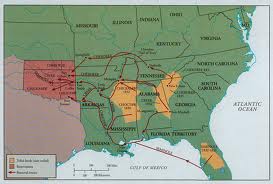
Interactive Map of Indian Country, Trail of Tears
The Indian
Removal Act, Cherokee Resistance and "Trail of Tears"
The Cherokee Memorials, 1263-1268
1. How are the "Memorial of the Cherokee Council" and the "Memorial of the
Cherokee Citizens" different from one another? Why do you think the Cherokee
chose to submit multiple memorials from different groups in the tribe rather
than a single memorial?
2. What kinds of attitudes toward land and land ownership do the Cherokee
memorials endorse? How do their feelings about their relationship to their land
compare to nineteenth-century white writers' attitudes toward land--Cooper's, for
example?
3. How do the Cherokee memorials compare to early national documents proclaiming
American sovereignty such as the Declaration of Independence or the
Constitution? How do the Cherokee memorials exploit traditional Euro-American
rhetoric of freedom and natural rights to their own ends?
4. What strategies of resistance do the Cherokee memorials employ? How do their
resistance strategies compare to those of the Sioux during the Ghost Dance of
the 1880s?
|
"I would sooner be honestly damned than
hypocritically immortalized." |
|
Davy Crockett
His political career destroyed because he supported the
Georgia Cherokee, he left Washington D. C. and headed west to Texas. |
Tuesday 10/26
Louise Amelia Smith Clappe, From
California, in 1851 and 1852. Residence in the Mines
2186-87 (the selection has changed from the previous Norton
edition. I'll get a pdf of Clappe letters posted soon)
1. Based on Clappe's
letters, what kind of role do you think women
occupied within the mining camps (which were populated mainly by men)?
2. What kinds of challenges would life in a mining town pose for women?
3. How do Clappe's remarks relate to what Patrick presented regarding
traditional masculine behavior, as well as homosocial and homoerotic
behavior?
4. How does the artist of "The Winter of 1849" depict life in a mining town
as compared to Clappe's experiences?
Yellow Bird (John Rollin Ridge, Cherokee), from
The Life and Adventures of Joaquin Murieta: The Celebrated California Bandit
1. What drives Joaquin
Murieta to a life of crime? What groups are targets
of criminal activity? What groups/individuals does he spare? What kind
of code does he live by?
2. Why do you think the figure of Joaquin Murieta was so appealing that
people were anxious to believe in his reality? Why has the story of his
life become such an important myth within California history?
3. What is the significance of the poem "Mount Shasta, Seen From a
Distance" at the end of the piece?
Student Mini-lectures:
"America Unbridled" The Iron Horse and Manifest Destiny":
Alyssa Laritz
"Star-Spangled Moccasins: The American Flag in Native American Culture":
Virginia Hutchings
"Competing Claims: The California Goldrush":
Margaret Rehfeld
Thursday 10/28
must cancel class for funeral
Tuesday 11/02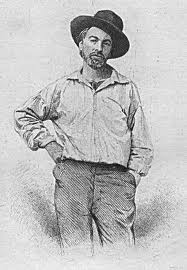
Essay 2 DUE
W. Whitman, 2127-31 (headnote); 2131-2138, (Preface to Leaves of Grass)Song of Myself, 2146-2189
1. Critics have called Whitman's 1855 Preface to Leaves of Grass a
literary declaration of independence. What does Whitman call for in a national
literature? Why does he feel America needs one? What kind of role does he
envision for the new American poet?
2. In Song of Myself, Whitman attempts to reconcile and bring into
harmony all the diverse people, ideas, and values that make up the American
nation. Which groups of people does he choose to focus on particularly? How does
he describe people of different races, social classes, genders, ages, and
profession?
3. (In class question) How does Whitman struggle with his commitment to
being a "public" national poet and his desire to record his private erotic
feelings in "Live Oak , with Moss"? How does he describe his love for men, given
that a vocabulary for homosexuality was unavailable to him?
4. What is "epic" about Song of Myself? Can you think of other American
texts that might be described as epic? What do these texts have in common? What
defines an epic?
5. Why do you think Whitman's poetry was so controversial in the mid-nineteenth
century (formal qualities and subject matter)? Do his poems still seem
controversial? In what ways? Where do you see Whitman's influence in later
developments in American poetry?
 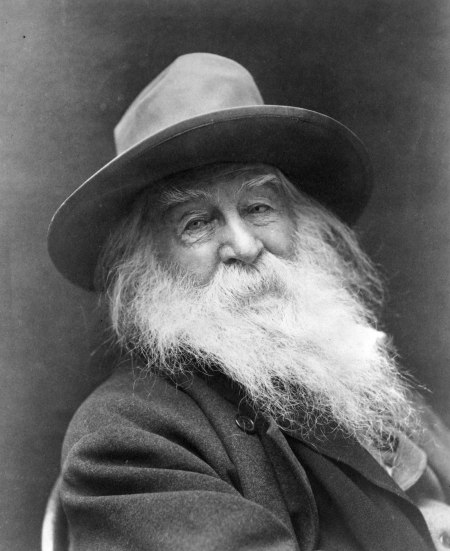
Defending Walt Whitman
By Sherman Alexie
Basketball is like this for young Indian boys, all arms and
legs
and serious stomach muscles. Every body is brown!
These are the
twentieth-century warriors who will never kill,
although a few sat quietly in
the deserts of Kuwait,
waiting for orders to do something, to do something.
God, there is nothing as beautiful as a jumpshot
on a
reservation summer basketball court
where the ball is moist with sweat,
and
makes a sound when it swishes through the net
that causes Walt Whitman to weep
because it is so perfect.
There are veterans of foreign wars here
although their bodies
are still dominated
by collarbones and knees, although their bodies still
respond
in the ways that bodies are supposed to respond when we are young.
Every
body is brown! Look there, that boy can run
up and down this court forever. He
can leap for a rebound
with his back arched like a salmon, all meat and
bone
synchronized, magnetic, as if the court were a river,
as if the rim were a
dam, as if the air were a ladder
leading the Indian boy toward home.
Some of the Indian boys still wear their military hair
cuts
while a few have let their hair grow back.
It will never be the same as it
was before!
One Indian boy has never cut his hair, not once, and he braids
it
into wild patterns that do not measure anything.
He is just a boy with too
much time on his hands.
Look at him. He wants to play this game in bare feet.
God, the sun is so bright! There is no place like this.
Walt
Whitman stretches his calf muscles
on the sidelines. He has the next game.
His
huge beard is ridiculous on the reservation.
Some body throws a crazy pass and
Walt Whitman catches it
with quick hands. He brings the ball close to his
nose
and breathes in all of its smells: leather, brown skin, sweat,
black hair,
burning oil, twisted ankle, long drink of warm water,
gunpowder, pine tree. Walt
Whitman squeezes the ball tightly.
He wants to run. He hardly has the patience
to wait for his turn.
"What's the score?" he asks. He asks, "What's the score?"
Basketball is like this for Walt Whitman. He watches these
Indian boys
as if they were the last bodies on earth. Every body is brown!
Walt
Whitman shakes because he believes in God.
Walt Whitman dreams of the Indian boy
who will defend him,
trapping him in the corner, all flailing arms and legs
and
legendary stomach muscles. Walt Whitman shakes
because he believes in God. Walt
Whitman dreams
of the first jumpshot he will take, the ball arcing clumsily
from
his fingers, striking the rim so hard that it sparks.
Walt Whitman shakes
because he believes in God.
Walt Whitman closes his eyes. He is a small man and
his beard
is ludicrous on the reservation, absolutely insane.
His beard makes
the Indian boys righteously laugh. His beard
frightens the smallest Indian boys.
His beard tickles the skin
of the Indian boys who dribble past him. His beard,
his beard!
God, there is beauty in every body. Walt Whitman stands
at
center court while the Indian boys run from basket to basket.
Walt Whitman
cannot tell the difference between
offense and defense. He does not care if he
touches the ball.
Half of the Indian boys wear t-shirts damp with sweat
and the
other half are bareback, skin slick and shiny.
There is no place like this. Walt
Whitman smiles.
Walt Whitman shakes. This game belongs to him.
Student mini-lecture:
"Picturing America: The Hudson River School Painters":
Millie Rose (Emily S)
"Corridos Then and Now": Manny Sanchez
Corridos, (American Passages site: background and corridos
in archives)
Corridos sin Fronteras (Ballads without
Borders)
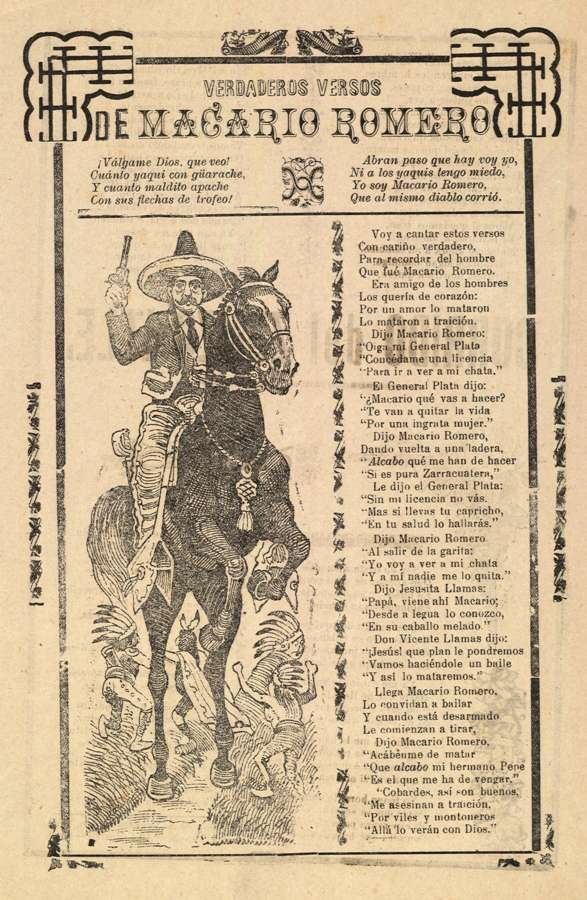
Thursday 11/04
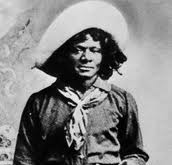
The
Life and Adventures of Nat Love
read chapters VI, XIII, XIV, and XXII
1. How do you read Nat's narrative in terms of nineteenth century ideals and
practices of masculinity?
2. Consider his race on his identity as a man and cowboy.
3. When taken captive by Yellow Dog's Tribe, how does Love portray his Native
American/African American captors? What seems to be his role within the tribe's
social hierarchy and how might it be influenced by race? How and why does he
escape?
4. We might expect Love to be bitter about the demise of the cowboy lifestyle
caused by the development of the railroad, yet he embraces his career as a
Pullman Porter. What does Love find appealing about the railroad?
5. Why do most pop cultural representations of the "Old West" portray most
cowboys as Anglo-Americans? How does Nat Love's autobiography challenge
traditional images of cowboy life? Does Love narrative also participate in
certain stereotypes?
Student Mini-lectures:
"Paradise of Bachelors: The Social World of Men in Nineteenth Century
America": Shelby Smith
"African American Cowboys":
Jens J.
Tuesday 11/09
UNIT 6: GOTHIC UNDERCURRENTS: Ambiguity and Anxiety in the Nineteenth
Century
VIDEO 6: Gothic Undercurrents
Unit 6 Overview
and Video Overview
Questions for Video:
How do these writers expect their work to be received by the
reader?
How do they express the social and personal anxieties of their time?
What assumptions or beliefs do they challenge?
Why do they remain compelling today?
What do they hope to achieve through their writing?
Herman Melville,
headnote: 2304-08, 2320-2363 (Moby Dick)
Compare Ishmael's thoughts about the pursuit of the white whale to Ahab's. What
might the whiteness represent for Ahab? What might Melville be critiquing?
Student mini-lecture:
"America on the Rocks: The Image of the 'Ship of
State'": John Sonnen
Thursday 11/11
Emily Dickinson, 2554-2558
E. Dickinson poems:
#258 (320)
What might "internal difference" mean? What are the "Meanings," and
why are they contained in internal difference? Why does the natural
experience of a certain winter light provoke reflection on internal
difference?
#328 (359)
How does Dickinson describe the bird in relation to the creatures in
the poem? In relation to the overall setting? The bird moves
throughout the poem, from the walk, to the wall, etc. What do these
movements symbolize? Is Dickinson making an environmental statement?
#465 (591)
This poem draws on the nineteenth century's fascination with deathbed scenes in
literature, but this poem is described from the point of view of the deceased.
What exactly does the poem's narrator experience, both sensuously and
psychologically? How does the fly affect the narrator's experience of death?
What is the narrator's take on
spirituality, and in conjunction, the afterlife?
#520(656)
What symbols, figures, and images in this poem are male, and which are female?
How do these symbols affect your understanding of the poem? How do they relate
to the idea of the cult of true womanhood Does this poem challenge or support
this ideology?
#732 (857)
How does this poem relate to the ideology of the cult of true
womanhood? Does it undermine social stereotypes and roles or support them?
What do you make of the juxtapositioning of "Pearl" and "Weed" in line 10? What
are "The Fathoms they abide-"?
#1129 (1263)
What might Dickinson mean when she writes "Tell all the Truth but tell it
slant"? What is she implying about the social structure? What is
the "Circuit"? Is there danger in the truth? Why does the narrator
refer to children?
407 (670) P. 2574
236 (324) p. 2563
269 (249) p 2565
Student mini-lectures:
"Swamps, Dismal and Otherwise":
Brittany Kienke
"The Spirit is Willing: The Occult and Women in the Nineteenth Century":
Caryssa C.
Assign Essay/Exam 3
Tuesday 11/16
E. E. Poe, "Ligeia" 1528-32, "Fall of the House of Usher," 1553-65
Student mini-lectures:
"Sleeping Beauty": Sentimentalizing Death in the Nineteenth Century":
Sarah H.
N. Hawthorne,
headnote: 1272-75; "Young Goodman Brown," 1289-98
1. What happens to Goodman Brown in the forest?
Why does Hawthorne
leave it up to the reader to decide whether the entire experience of
Brown is a dream or real?
To what extent does it matter that we decide
one way or another?
2. What does "Young Goodman Brown" seem to be saying about the ethics
of American Puritanism?
What does the ironic revelation of "evil"
hidden behind a facade of "good" suggest about Hawthorne's judgment of
the Puritan world view? About the idea of original sin? About
spiritualism?
3. What is the relationship between the female body and sin?
4. Though Goodman Brown doesn't give in to the "dark powers" in the forest, what
does he ultimately lose?
Thursday 11/18
C. Perkins Gilman,
"The Yellow Wallpaper"
print "The Yellow Wallpaper" and bring it to class
1. Describe the narrator of "The Yellow Wall-paper."
What is
wrong
with her (according to her husband and herself) and why does she spend all of her time in the nursery?
2. Describe the wall-paper. Why is she both fascinated and repulsed
by it? What might the wallpaper suggest? What does our narrator finally identify
in the wallpaper?
3. How does the narrator's husband treat her?
To what extent do you
think Gilman wants us to agree with John's opinion?
Can you see this
story as a commentary on the nineteenth century anxieties about
the "promises" of science and the ideals of the cult of true womanhood?
4. By the end of the story, the narrator seems to believe she has
achieved a victory: "I've got out at last,' said I, 'in spite of you
and Jane! And I've pulled off most of the paper, so you can't put me
back!'"
Do you agree that she has emerged victorious? If so, in what
sense?
Student Mini-lecture:
"Gothic Today (vs. Yesterday)?": Brittany Frasca
"Feminism and the Gothic" (see instructor):
Andrea Carr
Tuesday 11/23 and Thursday 11/25
NO CLASS: FALL BREAK
Tuesday 11/30
"Unnatural Reason/Weird Science":
Derek Arnold
UNIT 7: SLAVERY AND FREEDOM: Race and Identity in Antebellum America
Monday 11/14
VIDEO 7: Slavery and Freedom
Read the
American Passages
Overview, Unit 7
What is the relationship between literature and social reform?
How do these texts critique an entrenched racist ideology of white supremacy?
How do they recast American ideals of liberty and self-determination to include
African Americans?
What rhetorical strategies do they employ to effect social reform?
How do they work within the constraints of literary and social conventions and
yet still assert unique perspectives?
Historical Contexts and Stylistic Conventions that shaped the texts:
1) ideals of femininity and domesticity that shaped 19th Century
women's lives
2) the dynamic creole culture that African American slaves created out of
the adversity of their situation
3) slave strategies of rebellion and resistance
4) the issue of "miscegenation"
5) the mythology of the plantation
Learning Objectives:
1. understand how the antebellum debate about slavery transformed and expanded
foundational ideas about American identity and citizenship;
2. see and discuss the different strategies slaves adopted to resist white
authority and to develop their own distinct culture;
3. explain the importance of sentimentality and domesticity within the
nineteenth-century literature of social reform;
4. understand the role of literature in both shaping and reflecting political
reform movements.
1833: Lydia Maria Child publishes An Appeal in Favor
of That Class of Americans Called Africans, the first full-scale analysis of
slavery and race in the U.S., calling for the immediate abolition of slavery in
the South
John Brown/Raid on Harper's Ferry
http://en.wikipedia.org/wiki/John_Brown_(abolitionist)
Lydia Maria Child,
1078-1106 (headnote and Letters)
1) How do you see John Brown's raid on Harper's Ferry (the person Child and
Mrs. Mason are debating)
2) What role do biblical quotations play in Child's argument and why do you
think this might have been an effective rhetorical strategy?
3) Child published a collection of these letters to great success. Why do
you think she chose letters rather than essays?
Thursday 12/02
Essay 3 due
Harriet Beecher Stowe, 1698-1758 (headnote and Volume I from Uncle Tom's Cabin)
1) Critical evaluations have changed about Uncle Tom's Cabin, from a text of
great literary value to lesser value--due to its sentimentality, that is,
designed to appeal to the emotions--to important again. What is sentimentality?
As a rhetorical strategy what is its intentions? What constitutes a "classic" or
a "masterpiece"? What values underlie these aesthetic judgments?
2) How does Stowe use racial and gender stereotypes
in her characterizations? Do any of these characters challenge common
stereotypes? If so, how?
3) Uncle Tom's Cabin achieves powerful results by allying a discourse of
domesticity and sentimentality with a call for social reform. How does Stowe's
formula influence later American literature? Can you think of other novels that
adopt similar strategies?
Stowe, volume II: Chapters XX, XXX, XXXI, XXXIV (1758-1792)
Go Down Moses
|
Verse 1
When Israel was in Egypt's land
Let my people go
Oppressed so hard they could not stand
Let my people go
(Chorus)
Go down (go down)
Moses (do down Moses)
Way down in Egypt's land
Tell old, Pharoh
Let my people go!
Verse 2
Thus saith the Lord, bold Moses said
Let my people go
If not, I'll smite your first born dead
Let my people go
(repeat chorus)
Verse 3
No more shall they in bondage toil
Let my people go
Let them come out with Egypt's spoil
Let my people go |
Wade in the Water
1 - Wade in the water
Wade in the water children
Wade in the water
Don't you know that
God's gonna trouble the water
Don't you know that
God's gonna trouble the water
I stepped in water and the water is cold
Don't you know that
God's gonna trouble the water
Said it chilled my body but not my soul
Don't you know that
God's gonna trouble the water
Repeat 1
Well I went to the water one day to pray
Don't you know that
God's gonna trouble the water
And my soul got happy and I stayed all day
Don't you know that
God's gonna trouble the water
Repeat 1
There is love
(In the water)
In the water
(In the water)
There is joy yeah
(In the water)
In your water yeah
(In the water)
Your peace
(In the water)
Is in the water
(In the water)
Your deliverance
(In the water)
Is in the water yeah
(In the water)
Oh step in, step in
(In the water)
Joy is in the water
In the water yeah
(In the water)
Oh step in, step in
(In the water)
Love is in the water
(In the water)
Oh step in yeah
(In the water)
For deliverance
(In the water)
Everything
(In the water)
In the water yeah
Everything you need
(In the water)
Everything you need
(In the water)
Everything you need
(In the water)
Everything you need
(In the water)
Everything you need
(In the water)
Everything you need
(In the water)
Everything you need
(In the water)
Everything you need
(In the water)
God's gonna trouble the water
God's gonna trouble the water
(Yeah, yeah, yeah, yeah)
God's gonna trouble the water
(Ooh)
God's gonna trouble the water
Oh wade in the water
Steal Away, Steal Away to Jesus
|
Steal away, steal away, steal away to Jesus
Steal away, steal away home I haven't got
long to stay here
(S. Caesar)
My Lord, He calls me
He calls me by the thunder
The trumpet sounds within my soul
I haven't got long to stay here
(Michelle)
Green trees are bending
Sinner stands atrembling
The trumpet sounds within my soul
I havent't got long to stay here
(chorus)
(Michelle)
In the midnight hour
When you need some power
When your heart is heavy
Steal away, steal away home
I haven't got long to stay here
(S. Caesar)
My Lord, He calls me
He calls me by the lightning
(Michelle)
The trumpet sounds within my soul
I haven't got long to stay here
Repeat Chorus |
The Sorrow Songs (on American Passages site)
I will bring songs to play in class
1) How do these spirituals challenge and protest the institution of slavery?
what is subversive in these songs? Why do you think masters and mistresses for
the most part missed the rebellious implications of this music?
2) How does the Sorrow Songs' use of Old Testament images compare to the New
England Puritans' use of such images" Do the songs engage in a form of
typologizing? Why or why not?
3) How do you think the spirituals influenced the subsequent development of
American musical culture? What is the relationship between these early African
American songs and the subsequent African American musical forms, such as jazz,
blues, and hip hop?
Student mini-lectures:
" The Radical in the Kitchen: Women, Domesticity, and Social Reform": Kaci
Nicks
Tuesday 12/07
Abraham Lincoln,
1608-1617
1) Explain the significance of the "Gettysburg Address" in relation to the
battle.
2) Why do you think Lincoln chose the verse from the New Testament "A house
divided upon itself cannot stand" (Luke 11.17) as the basis for his speech? What
significance would this image of a threatened home have for nineteenth-century
Americans? How might it have resonated with American ideals of domesticity?
3) Lincoln's now celebrated speech was not well received when he first delivered
it on the battlefield at Gettysburg in November 1863. Apparently, it seemed to
concise and simple to the audience, which preferred Edward Everett's two-hour
sermon. Why do you think the speech was unsuccessful when Lincoln delivered it?
Today the "Gettysburg Address" is often viewed as a model of eloquence. Why has
it gained in popularity over time?
Wm. and Ellen Craft,
Running A
Thousand Miles for Freedom (read Part One)
1. Discuss the various boundary crossing (literal and symbolic) that occur
in the "Running." What kinds of boundaries do they seem to have the most
difficulty crossing?
2. Feminist and queer theorist Marjorie Gerber argues that cross-dressing is
usually a sign of "category crisis" in a text. That is it points to the
artificiality of other socially constructed categories such as race, class, or
sexuality. What categories besides gender are "in crisis" in Crafts' narrative?
Fredrick Douglass, 2029-2092 (Narrative)
1. What is the relationship between literacy and freedom in Douglass's
narrative?
2. What is the significance of Douglass's encounter with Covey the "slave
breaker" to the narrative and to his identity as a man?
3. Why does Douglass refuse to narrate the details of his escape and what effect
does this have on the narrative?
4. How does Douglass describe the Sorrow Songs in his text? How do they
effect him personally? What do they represent in slave culture? What does the
music they evolved into represent in contemporary American culture?
Student Mini-lecture:
"Resistance, Rebellion, and Running Away: Acts of Defiance in Slave Culture":
Megan M.
Thursday 12/09
Harriett Jacobs, 1757-1779 (Incidents in the Life of a Slave Girl)
harriet-jacobs-notice.jpg
Writing Exercise: Step into Harriet's shoes and make some decisions:
your master is close to raping you and your mistress is tormenting you, blaming
you for her husband's actions. What do you do?
1. For many years (until 1981) "Incidents" was believed to be a work of fiction
and written by a white author. Why would scholars have found it so difficult to
believe that a black woman raised in slavery could have written this book? What
qualities make the narrative seem fictional?
2. What strategies does Jacobs adopt in her efforts to resist her master? How
does she assert her rights over her own body and her children?
3. What is Jacobs's specific purpose in writing "Incidents in the Life of a
Slave Girl"?
4. Who was Jacobs writing to?
5. How does "Incidents" critique or appropriate 19th century ideals of
domesticity, sentimentality and womanhood?
6. How do "Incidents" and Douglass's "Narrative" compare? What goals, values,
and strategies do Jacobs and Douglass have in common? In what respects do they
differ?
Mini-lectures:
"The Plantation: Cultivating a Myth": Donald Terry
"Stirring Things Up: Slaves the Creation of African American Culture":
Jenny
Springer
"Beyond the Pale: Interracial Relationships and 'The Tragic Mulatto'":
Brian
Brown
TEN
THINGS EVERYBODY SHOULD KNOW ABOUT RACE
From: Race: The Power of an Illusion
pbs.org/race
Thursday 12/16
Final Paper due, 5 pm, Brink 200, English Dept. office
HAVE A GREAT BREAK!!
| 